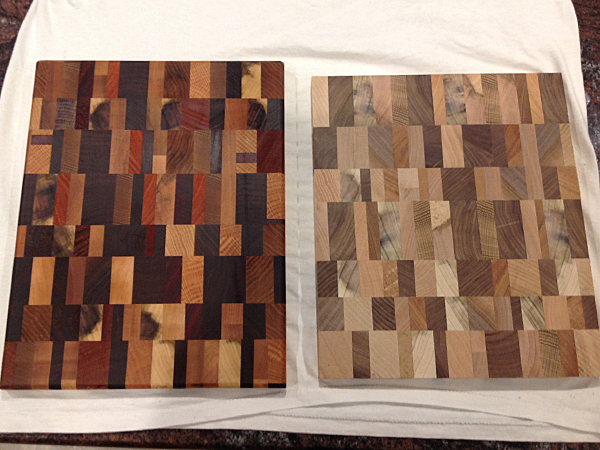
I am working on some breadboards to use as gifts for friends and family. I finished one with food-grade mineral oil as suggested by the website I was using. The trial board came out much darker than I hoped. Can anyone suggest another finish that would leave the surface more natural looking but still be OK for food contact? The oiled board in the photo above is on the left.
Chris Marshall: The upside to end grain in a cutting board is that it offers durability against cutting edges plus that unique and beautiful end-grain pattern. But, the downside is that end grain is going to absorb a lot of liquid wood finish — be that mineral oil, butcher block oil, salad bowl finish, diluted varnish or otherwise. Really, it’s the nature of the beast. And, among the oil alternatives, mineral oil is pretty clear, so you aren’t picking up much of a tint from the oil. It’s just the darkening effect of the oil penetrating into the wood pores. Over time, those breadboards will become lighter in color as the oil closest to the surface slowly evaporates or gets washed/wiped off and the rest continues to migrate deeper into the wood — mineral oil never fully dries. But, I doubt they will ever be as light as they were before oil was applied.
You might try a blend of melted beeswax mixed with mineral oil as an alternative lighter-colored wipe-on finish. Beeswax offers some protection against food stains, and it won’t penetrate or darken the wood to the same extent as more concentrated oil alone. But even so, there still will be some darkening effect.
Rob Johnstone: I’m with Chris on this one. The only suggestion I might have is that you technically don’t need to put a finish on a cutting board at all. If you were to sand it carefully up to 600-grit, the wood will be so smooth that it actually looks a bit like there is a finish. Many cutting boards don’t have a finish on them.
Other eZine readers, please offer your suggestions for a non-darkening food-safe finish solution.





